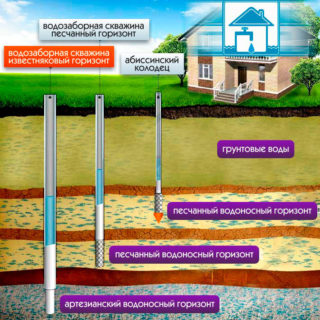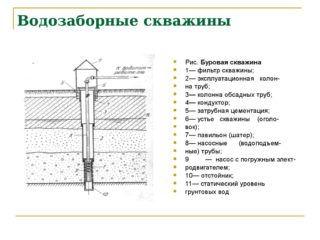Well depth is an indicator that determines the quality of water and the price of drilling work. Each extra meter of water intake arrangement is an investment and effort. At the same time, shallow wells are only suitable for technical needs. Therefore, it is so important to determine the optimal depth criterion in order to obtain the most favorable ratio between investment and water quality.
Factors affecting depth
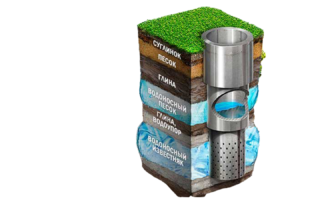
Before designing a well, it is necessary to determine the depth. There are several criteria to consider:
- The level at which the aquifers are located. To determine the test drilling or analysis of the area is carried out, taking into account the geological structure.
- Terrain relief. In places without drops, the water layer can be close to the surface; in a hilly area, it is better to drill in a lowland.
- Purpose of water intake. How many meters the well should be for water is determined depending on what the liquid will be used for. The deeper the source, the cleaner the water.
To determine the minimum depth of a well for water, they certainly take into account the peculiarities of the area - geological and climatic. In areas with large forests and high humidity, reserves in underground sources are usually large, located relatively close, in some places they come to the surface in the form of springs. In arid steppe areas, the aquifer may be at a considerable depth or be absent altogether.
In addition to these factors, it is necessary to take into account the very location of the water intake structure. Indeed, even a zone that is potentially convenient in terms of depth indicators may turn out to be inappropriate.
It is prohibited to punch wells near such places:
- cemeteries;
- garbage dumps;
- agricultural fields that are treated with herbicides and nitrate fertilizers;
- industrial facilities.
If there is a hill on the site, it is impractical to drill at its top, it will be very far to the water.
Well types
The accumulation of groundwater occurs above the first water-resistant layer from the surface at a depth of more than 15 m. Since they do not overlap from the top with an aquiclude, they rarely meet drinking standards and are subject to seasonal fluctuations.
The mines are pierced to a loose moisture-saturated layer of the earth. In areas where rainfall is low, such underground sources may not be available.
Interstratal aquifers are located between two water horizons, there may be several of them. The water quality is high. They are very rarely located close to the surface, but not higher than 20 m. Most often they are located at a depth of over 60 m.
Depending on the water horizon in the territory, you can create the following types of water intakes:
- an ordinary well of about 5 m, fed from the top water;
- a well that breaks through to sand layers to a depth of 10 to 30 meters;
- Abyssinian well fed from the same layers as the sand well;
- artesian source.
In the latter version, the liquid flows between the lime layers, that is, during drilling, the aquifer breaks through. The depth of drilling an artesian well for drinking water is more than 50 m.
The type of water intake determines the quality of the water, the difficulty of creating and the productivity of the well. In accordance with the Russian law "On Subsoil", it is possible to punch a borehole and use a source from the first water layer without going through a special registration. In this category there are water intakes from the top water, a well for sand, an Abyssinian well.
The water from the artesian spring is much cleaner, but such a hydrological structure requires a license, which is very expensive.
It is also necessary to calculate the required flow rate. In addition to quality, the volume of liquid that they receive over a certain time interval is also important for water consumers. In Abyssinian wells, this value is equal to half a cubic meter per hour, in a well on sand, the volume increases to one and a half cubic meters per hour, the maximum productivity at an artesian well is up to 3-4 cubic meters per hour.
Optimal depth indicators
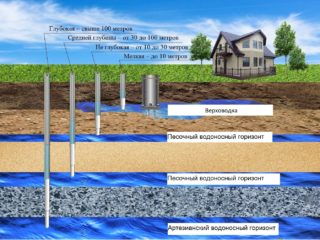
It is rational to drill the hole to the depth that is allowed without additional documents and payments. In some localities, this figure reaches 35 meters, which depends on the hydrogeology of the land. You can drink such a liquid only by installing filters that clean it from iron, heavy metal salts and lime.
To select a suitable filtering device after the creation of a hydraulic structure, it is necessary to take a water sample and send it for laboratory analysis. Then it will be clear which contaminants prevail in the liquid and what should be protected from.
When choosing the optimal depth, you can use indirect signs - for example, check the size of water intakes from your neighbors. But it is wrong to equip your well, relying only on their characteristics. Aquifers do not lie evenly, and there is no guarantee that they will be located on your site in the same way as on the neighboring one.
It is also worth examining the geological survey data that can be requested from the district administration. There are terrain plans created on the basis of engineering and reconnaissance activities. They contain information about the specifics of the soil and the occurrence of water horizons.
The most accurate answer will be provided by drilling exploration. With its help you can:
- find out the potentially beneficial mine depth;
- identify the composition of soil layers;
- to make a water intake for laboratory research.
If you need to analyze water from the upper layer, exploration drilling can be done by hand. This requires a conventional hand drill and extension rods.
How to determine the depth of the water intake
In the presence of a well that is not documented, all this data will have to be obtained by the owner of the source.
To find out the depth, you will need a long cord, a weight on a cable, a tape measure. You just need to lower the cable into the shaft and find out its length. But in order to determine static and dynamic levels, and calculate the flow rate, you will need special devices - level meters.
The most suitable time for taking measurements is dry weather at the end of the summer season or late spring, when the watering of the gardens has already begun. During this period, the water level is at the minimum mark
Stages of arrangement of a hydraulic structure
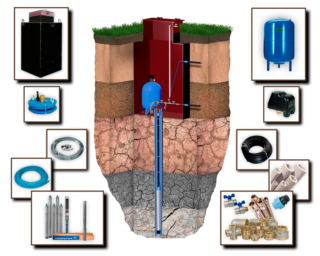
First, you need to decide on the type of well and drilling technology.The following steps are standard and do not depend on whether the water intake is set up independently or by professionals:
- Selection of equipment for drilling, tools, consumables, technology.
- Arrangement of the caisson, if it is provided for by the design.
- Drilling the first section of a hydraulic structure with the installation of a casing string.
- Drilling the second section, securing it with pipes.
- Cleaning the borehole when passing through a sandy or clay layer.
- Reaching the desired water horizon.
- Installation of a bottom filter of a hydraulic structure.
The work is completed by fixing the casing, installing pressure equipment and a cover.
The creation of the Abyssinian well is slightly different. This is the simplest and most inexpensive type of water intake, also referred to as "needle-well". Structurally, it looks like a long inch pipe with a needle-shaped tip and a filter element. The “needle” is deepened by drilling or simply driven into the ground by 8–30 meters. The liquid is supplied using pumping equipment, but from a depth of no more than 8 meters. Such wells can be developed in areas with light, non-rocky soils.
The quality of water and the uninterrupted supply of water depend on the correctly calculated depth of water intake. To identify the optimal indicator, you need to build on your own needs, from the underground water map and the technical capabilities of drilling.

